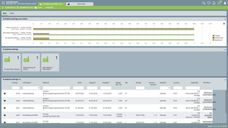AspenTech Solution achieves major advance in modeling processes with multi-stream heat exchangers
New heat exchanger simulation brings greater value to process design
Advertisement
CAMBRIDGE, MA - Aspen Technology Inc. today announced a major advance in the design and operation of processes involving multi-stream heat exchangers. This innovation in the Aspen Engineering Suite (AES) modeling and optimization technology will enable improved decision-making and optimal Process Asset Lifecycle Management in a range of important applications including air separation processes and the production of liquid natural gas (LNG) and ethylene.
These new AES capabilities are part of the latest release of HTFS MUSE, the leading commercial technology for plate-fin heat exchanger modeling. For the first time, advanced simulation of multi-stream plate-fin units using MUSE can be carried out within HYSYS (R), AspenTech's process design and modeling environment for the Upstream Oil & Gas and Refining industries. The integration of these two products enables companies to simulate their processes more accurately, accelerating the passage from conceptual design to detailed design, and allowing manufacturers to improve asset performance by enhancing their ability to optimize plant operations.
"As a leading provider of processes including air separation, hydrogen, LNG and ethylene production, Linde Engineering makes significant investments in the integration of best-in-class engineering design software, said Thomas Hecht, Manager of Heat Transfer and Process Design Integration at Linde Engineering. This allows our company to fully liberate the value of process opportunities, reduce engineering costs and design cycle times, and deliver exceptional solutions to our customers. As long-term users of both MUSE and HYSYS, we are delighted to endorse AspenTech's initiative in integrating the functions of these powerful software tools."
The new release HTFS MUSE 3.30 delivers fast, seamless run-time integration with HYSYS, enabling state-of-the-art multi-stream plate-fin simulation within a process. The globally accepted AspenTech HTFS+ research-based thermal-hydraulic methods, along with a HYSYS native user interface and an expert environment for design of plate-fin units, are also part of the updated product.
"AspenTech is delighted to bring the benefits of the modeling rigor provided by MUSE into the process simulation domain, enabling our customers to make more precise and objective business decisions, said Manolis Kotzabasakis, Sr. Vice President of Engineering at AspenTech. These can include operating decisions, such as how to maintain maximum profitability when impacted by feedstock changes, or decisions within the design process, such as the analysis of the payback of new plant concepts. We have maximized the value delivered by the MUSE program by ensuring that our unique technology and expertise in plate fin exchangers is regularly updated by the HTFS research program, which is steered by our customers through the Compact Heat Exchangers Review Panel.




























































